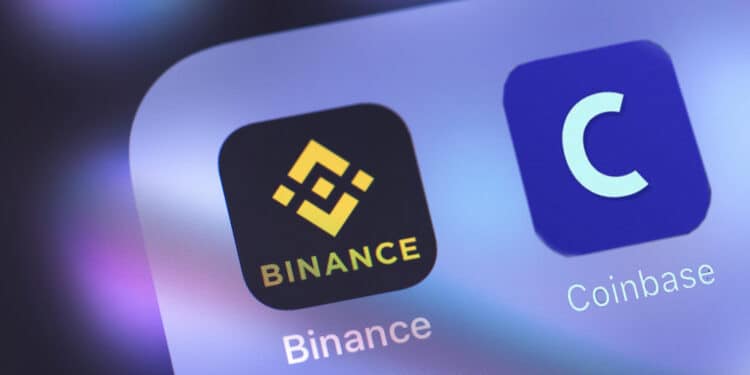The fees charged by an exchange is one of the most significant elements to consider when deciding which one to choose. Each exchange has its own cost structure, with some being more expensive than others. In recent years, Coinbase and Binance have become highly popular. While Coinbase is one of the most well-known and well-established cryptocurrency exchanges, Binance has recently expanded to become the largest cryptocurrency exchange.
Binance has a dedicated platform for investors in the United States called Binance.US. This exchange has a smaller range of coins and fewer features than the main exchange. Coinbase is split into two platforms: Coinbase and Coinbase Pro. Coinbase Pro caters to more experienced traders, whereas Coinbase is designed for first-time cryptocurrency investors.
What is Binance?

Binance was created in 2017 by Changpeng Zhao and Yi He and is situated in Malta, a European Union country. Binance is unique in that it is both a cryptocurrency exchange and has its own token; BNB Investors and traders can utilize BNB to execute transactions on Binance and save money on trading fees as a result.
Binance allows you to purchase, sell, and trade cryptocurrency. It also allows you to engage in more advanced trading strategies and provides strong charting tools. There’s also an over-the-counter function that lets you trade directly with other users, potentially allowing you to make agreements that aren’t entirely reliant on market prices.
What is Coinbase?

Coinbase, situated in San Francisco, was created in 2012 by Brian Armstrong and Fred Ehrsam. It’s a publicly-traded company that trades under the ticker COIN on the NASDAQ platform. It’s simple to purchase, sell, and exchange various cryptocurrencies using Coinbase. There are various supported trading pairs, so you don’t have to convert your tokens to fiat cash every time you want to buy something else. Coinbase provides the opportunity to earn rewards. You may earn tokens by learning about numerous altcoins, allowing you to diversify your holdings
Binance vs. Coinbase fees
Deposit fees
Binance has no deposit fee. Users can purchase cryptocurrencies straight from Coinbase (with higher costs) or deposit funds into Coinbase first, then make a transaction. Your Coinbase account can be funded using an Automated Clearing House (ACH) deposit, wire transfer, or Single Euro Payments Area (SEPA) transfer. It is free for ACH transfers, $10 USD for wire transfers, and €0.15 EUR for SEPA transfers.
Trading fees
Maker-taker pricing is used by both Coinbase and Binance, with fees based on whether you contribute liquidity to the market (makers) or remove liquidity from the market (takers). Users are termed “takers” and pay the taker fee when they place an order at the market price that is instantly filled. When a user places an order that is not immediately matched, the order is placed in the order book (until a match is discovered), and the user is designated a “maker” and charged a maker fee when the transaction occurs. As a result, trading costs vary depending on both your volume and the sort of trade you execute.
Binance trading fees
| 30-DAY VOLUME | MAKER | TAKER |
|---|---|---|
| Less than $50,000 | 0.10 percent | 0.10 percent |
| $50,000 – $100,000 | 0.09 percent | 0.09 percent |
| $100,000 – $500,000 | 0.08 percent | 0.09 percent |
| $500,000 – $1 million | 0.07 percent | 0.08 percent |
| $1 million – $5 million | 0.05 percent | 0.07 percent |
| $5 million – $10 million | 0.04 percent | 0.06 percent |
| $10 million – $25 million | 0 percent | 0.06 percent |
| $25 million – $100 million | 0 percent | 0.05 percent |
| $100 million – $250 million | 0 percent | 0.04 percent |
| $250 million – $500 million | 0 percent | 0.03 percent |
| $500 million and up | 0 percent | 0.02 percent |
Coinbase trading fees
| 30-DAY VOLUME | MAKER | TAKER |
|---|---|---|
| Less than $10,000 | 0.50 percent | 0.50 percent |
| $10,000 – $50,000 | 0.35 percent | 0.35 percent |
| $50,000 – $100,000 | 0.15 percent | 0.25 percent |
| $100,000 – $1 million | 0.10 percent | 0.20 percent |
| $1 million – $10 million | 0.08 percent | 0.18 percent |
| $10 million – $20 million | 0.08 percent | 0.18 percent |
| $20 million – $50 million | 0.05 percent | 0.15 percent |
| $50 million – $100 million | 0.05 percent | 0.15 percent |
| $100 million – $300 million | 0.02 percent | 0.10 percent |
| $300 million – $500 million | 0 percent | 0.08 percent |
| $500 million – $750 million | 0 percent | 0.06 percent |
| $750 million – $1 billion | 0 percent | 0.05 percent |
| $1 billion – $2 billion | 0 percent | 0.04 percent |
| $2 billion and up | 0 percent | 0.04 percent |
Binance charges less than Coinbase whether you’re doing small or large volumes. Furthermore, if you pay trading fees with BNB, Binance will reduce your fees by another 25%.
Withdrawal fees
When you withdraw money from Coinbase, you’ll be charged a network fee that fluctuates based on how busy the network is at the time and whatever cryptocurrency you’re withdrawing. It usually ranges from $1.00 to $5.00 for Bitcoin, while it’s usually less than $1.00 for other cryptocurrencies.
Users pay a fixed fee for each withdrawal to cover the transaction costs of transferring cryptocurrency out of their Binance account. The blockchain network determines withdrawal rates, which might fluctuate without warning due to factors such as network congestion. Bitcoin, for example, has a minimum withdrawal of 0.001 and charges $0.0004 for it.
How can you reduce Binance fees?
If Binance Coin (BNB) is used to pay for fees, Binance normally charges cheaper costs. To use BNB to pay for fees, just hold BNB in your Binance account. This balance will be used to deduct fees for any transactions you complete. This is less than the standard 0.1% transaction fee imposed by the exchange.
Using BNB to pay for fees also ensures a 25% discount on spot and margin trading fees, as well as a 10% discount on futures trading fees. For VIP members, the discounts are much greater.
How can you reduce Coinbase fees?
You can avoid paying fees if you use Coinbase as a ‘Gateway’ platform to buy cryptocurrencies and then move the funds to other exchanges to trade with. When converting from USD to Coinbase’s native stablecoin USD Coin (USDC), there are no costs. Your funds will be available to withdraw after 3-5 business days if the transaction is completed using a US bank account. The USDC can then be transferred immediately to other exchanges, such as Binance, and trading can begin. You can avoid withdrawal fees by signing into Coinbase Pro and withdrawing money through it.
Summary
Between Binance and Coinbase, which charges more, and is it worth it? This comparison of Binance and Coinbase clearly reveals that Binance’s fees are far lower than those of Coinbase. Coinbase, while being a prominent exchange and the first to go public, is known for its exorbitant fees, although it is not worth it. Binance is the way to go if you’re seeking a better exchange with lower costs among the two.




